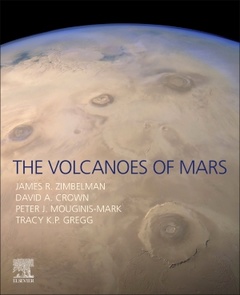Description
The Volcanoes of Mars
Authors: Zimbelman James R., Crown David A., Mouginis-Mark Peter J., Gregg Tracy K. P.
Language: English
Subjects for The Volcanoes of Mars:
146.54 €
In Print (Delivery period: 14 days).
Add to cart260 p. · 19x23.3 cm · Paperback
Description
/li>Contents
/li>Readership
/li>Biography
/li>Comment
/li>
The Volcanoes of Mars offers a clear, cohesive summary of Mars volcanology. It begins with an introduction to the geology and geography of the red planet and an overview of its volcanic history, and continues to discuss each distinct volcanic province, identifying the common and unique aspects of each region. Incorporating basic volcanological information and constraints on the regional geologic history derived from geologic mapping, the book also examines current constraints on the composition of the volcanic rocks as investigated by both orbiting spacecraft and rovers. In addition, it compares the features of Martian volcanoes to those seen on other volcanic bodies.
Concluding with prospects for new knowledge to be gained from future Mars missions, this book brings researchers in volcanology and the study of Mars up to date on the latest findings in the study of volcanoes on Mars, allowing the reader to compare and contrast Martian volcanoes to volcanoes studied on Earth and throughout the Solar System.
1. Introduction: Welcome to Mars!2. Aerography3. The Tharsis Province4. The Elysium Province5. The Circum-Hellas Province6. Syrtis Major and Small Highland Volcanoes7. Medusae Fossae Formation and the Northern Lowlands8. Igneous Composition9. Lava Worlds: Cosmic Cousins10. What’s Next?
Advanced undergraduate to beginning graduate students and researchers studying Mars and volcanology (including Earth Science)
David A. Crown is a Senior Scientist at the Planetary Science Institute (Tucson, AZ), with professional interests in planetary geology, physical volcanology, remote sensing, and science education. His research studies focus on understanding the geologic histories of the rocky planetary bodies in the solar system and include geologic mapping investigations of the surfaces of Mars, Venus, Io, and Ceres, use of spacecraft and airborne remote sensing data for geologic analyses of planetary surface features, field investigations of volcanic deposits, and the development and application of models for geologic flows. He has published nine geologic maps of Mars to-date, eight of which examined the geology of the Hellas region. He has conducted field studies of volcanic terrains in the western continental US, Hawai’i, Mexico, and in the Central Andes of Bolivia.
Peter J. Mouginis-Mark is an Emeritus Researcher at the Hawai‘i Institute Geophysics and Planetology (HIGP), University of Hawaii (UH). For more than 40 years, he has studied volcanoes in the Solar System and on Earth. He has conducted field work not only in Hawai‘i, but also such diverse places as the Galapagos Islan
- Presents clearly organized text and figures that will quickly allow the reader to find specific aspects of Martian volcanism
- Includes definitions of geological and volcanological terms throughout to aid interdisciplinary understanding
- Summarizes key results for each volcanic region of Mars and provides copious citations to the research literature to facilitate further discovery
- Synthesizes the most current data from multiple spacecraft missions, including the Mars Reconnaissance Orbiter, as well as geochemical data from Martian meteorites
- Utilizes published geologic mapping results to highlight the detailed knowledge that exists for each region
These books may interest you

The Encyclopedia of Volcanoes 173.83 €



